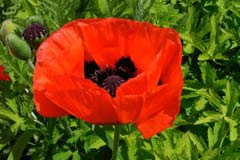- Out-of-Stock



The orange oriental perennial poppy, originally from Turkey. The blooms are impressive, and in good conditions the plant will make a large perennial clump in only a few years. Remove the first flower and avoid acid soils.
The orange oriental perennial poppy, originally from Turkey. The blooms are impressive, and in good conditions the plant will make a large perennial clump in only a few years. Remove the first flower and avoid acid soils.
Data sheet
Winter flowering species with apricot and green flowers, soft grey blue folage, likes clay soil types.
Old fashioned colour rarely seen in contemporary gardens, easy plant, reproduces from bulbs. Best in dry well drained soil, sunny conditions. Note this is a winter dormant bulb.
Tall variety. Flowers begin very soft primrose then fade to white; the range of tonal shades within yarrow flowers is endless.
The best red monarda; mildew resistant and tough as they come. Like all monarda, these grow best on fertile clay loam or well mulched moisture retentive soil types.
Tiny grey foliage ground cover for the rock garden which will tolerate dry conditions. Easy and long lasting, good with saxifrage and auricula.
Slender wiry stems topped with lolly pink pompoms about the size of a mulberry, flowering for months in summer. Like other sanguisorba they are drought tolerant, but like some clay below the surface.
This variety is particularly good in autumn when the seedheads elongate and stand above the foliage. Another tall variety for behind the border, best cut down to ground level every few years.
Prolific carpeting ground cover flowering in spring, along with phlox, auriculas, and pulsatilla. They look best tumbling over a wall or in a rock garden where they get good sun and drainage.
Pink 'Pacific Giant' strain. Requires good soil and drainage to flourish. Delphiniums are best situated in an easterly aspect with morning sun only, protected from hot afternoon sun and drying wind.
Improved strain from Germany with multiple stems and darker blue flowers than the species. Good for cutting and drying.
A robust cold-hardy species from the Balkan peninsula, this salvia is versatile: happy in both warm and very cold climates. If temperatures drop below -5 C the plants will become deciduous, however can remain evergreen in warmer climes. Violet purple flowers and attractive greyish hairy leaves.
Rich purple flowered variety, more mildew resistant than others in our area. Tall and self supporting non staking variety, useful as a cut flower.
Tall spiky plant with silver spherical heads. Great for flower arrangements and texture in the summer border. Best with morning sun only and enough water during summer.
A wonderful new grey foliage variety with lilac flowers, which eventually turns into a small shrub. Very drought tolerant and evergreen throughout the year. Treat like a lavender with a light trim after flowering.
A striking biennial for shade, forming strong mounds of good foliage and normally flowers in second or third year once the plant has acheived maturity, after which it will self seed. This is the rarely offered white form, the common form is pink.
A branching form of Russells lupin with white and cream flowers. Provide good drainage and dry off in summer, looks wonderful with white roses.

The orange oriental perennial poppy, originally from Turkey. The blooms are impressive, and in good conditions the plant will make a large perennial clump in only a few years. Remove the first flower and avoid acid soils.